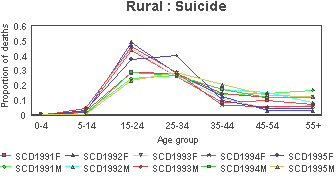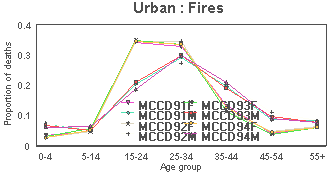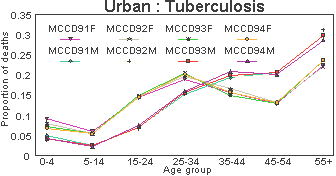|
Validity of SCD-Rural disease-specific algorithms:
As the WHO-UNICEF (1994) consultation noted, VA is suitable only for causes that have clear and unambiguous set of symptoms at the time of death. The symptoms and signs chosen to code deaths due to a particular disease should result in most of the deaths truly due to the concerned cause to be coded as such (sensitivity) and exclude other causes that may have related symptoms. In addition, the choice of symptoms and signs must be parsimonious to reduce interviewer and interviewee fatigue. At the very least, questions and coding algorithms should have face and content validity. In other words, they should be based on expert judgment about their usefulness in identifying and excluding specific causes. In addition, validity with respect to a criterion will be desirable. The validity of an instrument is assessed by comparing its result with some reference standard. Thus the choice of a reference standard is the key to empirical validation of VA algorithms.
The gold standard reference for assignment of cause of death has been the autopsy. This is not a practicable solution to validate VA, since the later alternative to medical certification of cause of death is considered only in areas with scarce medical facilities. Two other references have been proposed (LSHTM, 1993) and used, namely (a) hospital diagnosis and (b) clinical diagnosis. To validate VA with respect to hospital diagnoses, deaths in a community are coded using the VA instrument under testing. If the deceased happened to have been hospitalized, the medical records from hospital are retrieved. The reference cause of death is assigned on the basis of the person's medical record in hospital. Alternatively patients discharged from a hospital may be followed up after a lapse of time and deaths if any may be coded by VA. The hospital-based reference diagnosis and the VA-based code are then compared. Selection bias is a major shortcoming of hospitals based reference. The LSHTM workshop discussed possible ways of reducing selection bias. An example of hospital diagnosis-based reference is the study in Kenya by Snow et al (1992). In this study hospital diagnosis was used as a reference to check validity of cause of death coded by physicians from verbal autopsy data. On the other hand, clinical diagnosis in the community has less of a selection bias. This would require a lot of medical manpower, which may not be available in an area for which VA is considered. It may, however, be possible to temporarily mobilize physicians for purposes of a validation study, since methodological lessons learnt from it would be useful for wider application. Kalter et al (1990) used physician diagnosis as the reference to estimate validity of different verbal autopsy based algorithms. Zimicki (1990) compared interviews by lay reporters with in-depth interview by physicians.

Sometimes empirical validity of VA tools are assessed indirectly by checking consistency of VA-based statistics with known epidemiological patterns. One approach has used known efficacy of vaccination to reduce mortality due to concerned disease. Validity of a VA tool measuring mortality due to that disease may be indirectly inferred from the time trend of estimates generated by it and vaccination coverage. Stephens (1990) studied measles-related morbidity and mortality data collected by nonmedical field interviewers in a rural area in Senegal. Data on measles incidence and cause-specific mortality was aggregated by hamlets. Stephens examined if the movement of measles epidemic from hamlet to hamlet implied by the verbal autopsy data was consistent with known epidemiologic pattern of measles and vaccination coverage in respective hamlets.
SCD-Rural algorithm organizes all causes, at the highest level, into ten modules based on obvious age-sex-major symptom complex. The solution to the first round of questions about applicability of these modules leads the interviewer into the detailed questions under that module. It will be fairly obvious to determine if the death was due to, say, accidents and injuries (SCD module-1), maternity (module-2) or if it was of an infant less than one year old. There is a problem about the last module on senility. There are no further expansions of causes under senility. Criteria for inclusion under senility is that the person was extremely old and apparently not sick? The person should be above 60 years and none of the specific causes in SCD list be traced. The age criteria of more than 60 years would tend to put more deaths under this category.
SCD (Rural) cause groups, availability of expert opinion or validity information on each cause and concordance of SCD questions with expert opinion. |
|---|
| Category[1]
| Not Available |
Availability and Concordance[2] |
| Faculty & Coordinators |
Influenza, Typhoid |
Malaria |
| Digestive disorders (6) |
Food poisoning, Peptic ulcer, Acute abdomen |
Gastroenteritis (diarrhoea), Cholera, Dysentery |
| Coughs (5) |
|
Tuberculosis of lungs, Bronchitis, Asthma, Pneumonia, Whooping cough |
| CNS disorders (3) |
|
Stroke, Meningitis, Convulsions |
| Diseases of the Circulatory System (3) |
Anaemia |
Congestive heart failure, Ischaemic heart disease |
| Other clear symptoms (13) |
Cirrhosis and chronic liver diseases, Chicken pox, Leprosy, Poliomyelitis, Mental disease, Diabetes, Hyperplasia of prostate, Uraemia, Obstructed hernia |
Jaundice, Measles, Tetanus, Cancer |
| Infant deaths (6) | | Prematurity, Congenital malformation, Birth injury, Respiratory infection of the new born, Cord infection (Neonatal tetanus), Diarrhoea of the new born |
[1] Figures in parentheses are the number of conditions within the group. For 12 causes under Accident and Injuries, expert opinion is not available for an individual or specific cause. However, there is a general agreement that these causes are obvious to lay reporters and hence verbal autopsy is considered to accurately assign deaths due to these causes. For similar reasons, the six causes under maternal deaths is not shown. Senility and other residual codes are not shown.
[2] Expert opinion and SCD questions for the underlined causes of death listed under this column do not agree. |

The SCD structured questions and checklist were compared with currently available expert opinion or validity information for respective causes of death in the SCD non medical list. Altogether there are 57 specific causes in the SCD non- medical list, excluding the residual categories. Accidents and injuries account for 12 of these. Consensus about validity of VA to code deaths due to accidents and injuries is quite strong, since most of these are easily recognized by lay persons. Discussions of VA on accidents and injuries are not available in the literature. So is the case with deaths due to maternal causes, under which SCD non medical list contains 7 causes. Excluding these 19 causes under accidents, injuries and maternal deaths, there are 38 specific codes in the rest of the SCD non- medical list. At least some expert opinion or validity information is available for 24 out of these 38 causes.
As can be seen in the above table , most of the causes for which some expert opinion is available are infant deaths, respiratory and diarrhoeal diseases. For 21 out of these 24 causes the SCD questions appear to be in accordance with expert opinion and validity information available in the literature. The three causes for which there is major discrepancy are (a) cord infection, (b) pre maturity, and (c) cancer. Most experts agree and validation studies show that verbal autopsy is good at detecting neonatal tetanus. In SCD-Rural, neonatal tetanus is included under cord infection and thereby misses an opportunity for accurate estimation of deaths due to a cause which is very important from public health point of view. Experts opine that it is usually difficult to distinguish between prematurity and low birth weight (Garene and Fontaine, 1989; Gray, 1989). Hence they ought to be lumped together for accuracy of VA-based statistics. The SCD-Rural list does not include low birth weight in its list. It can be added to prematurity without any disturbance to the structure of the rest of the questionnaire. The SCD-Rural list homogenizes all cancers into one cause. Some expert opinion is usually available by site of cancer. Moreover some cancers would have symptoms which may be confused with the filter questions for other modules. For example, stomach cancer cases may be investigated as deaths due to digestive diseases. In that case, the field agent may not get to consider stomach cancer at all since there is no mention of it in the digestive causes module. So is the case for lung cancer.
Nonavailability of expert opinion or information pertaining to validity in the SCD-Rural nonmedical list does not imply that they are primaital facie not valid. The SCD-Rural design was based on expert opinion obtained at the time of drawing up blue print of the scheme and revision of manuals. The SCD-Rural design process included a phase of field testing of provisional questionnaires and finalisation by expert consultation. Considering the large extent to which questions for specific causes are in accord with expert opinion and information from VA validity studies, the SCD-Rural questionnaire appears to be prima facie valid.
The prima facie validity of SCD-Rural questionnaire is reassuring in the sense that the scheme design is largely in accord with current knowledge about verbal autopsy. But it does not assure us that the cause of death statistics are accurate for all causes. In case of causes for which VA is known to be highly sensitive and specific (say more than 75% for each) the SCD statistics can be mapped to medical causes directly. For other causes, more detailed algorithms for mapping of SCD statistics onto the desired set of medical causes will have to take into account available knowledge about the sensitivity and specificity of VA in general and specific peculiarities of SCD as also implementation.
From January 1999, the survey of cause of death was integrated with the SRS (RGI, 1999). It is understood that the SCD-Rural guidelines have been extended to the SRS-COD component. Although formal communication regarding this is yet to be made available, we were able to obtain a copy of the RGI rules and regulations on "Collection of data on causes of death" (Director of Census Operations, Andhra Pradesh, 1999). The elimination of the symptom record (SCD-Rural Form-7) has been a major departure from the SCD-Rural design. The SCD-Rural symptom record was similar in content to the WHO's cause of death report format, which requires information about the underlying causes of death. The SRS-COD component asks field agents to record the code to which the cause of death is assigned. No further information about symptoms and circumstances of death need be reported. This later information is required for the systematic screening and coding of cause of death reports. The phasing out of the structured questionnaire constitutes another significant departure from the SCD - Rural. Instead the instructions contain a list of causes, related symptoms for some diseases, and the corresponding ICD10 code. For some causes, no description of expected symptoms has been furnished. However, it is too early to sit in judgment on the new system. It will nevertheless be helpful if specific research studies are taken up to evaluate the performance of the new cause of death reporting system in rural areas.
The SRS-COD component is designed to generate verbal autopsy-based information on the causes of death for urban and rural areas, since SRS operates both in rural and urban areas. This will result in two sources of cause of death data from urban areas, namely the (a) SRS-COD component, and (b) the Medical Certification of Cause of Death (MCCD) reports. It is claimed that this will allow for comprehensive statistics on cause of death for all areas of India. While the availability of verbal autopsy-based cause of death data for urban areas will allow for some plausibility checks and comparisons with the MCCD based data, the latter source is certainly more preferable, as it is based on medical certification. Urban areas face the hazard of poor co-operation offered by hospitals and medical attendants. This is mainly due to the fact that there is no effort, whatsoever by municipal authorities in demanding compliance with provisions of the Registration of BD Act. about reporting of cause of death.

Incidence of improbable age sex distribution by cause:
Age distribution of deaths attributed to selected causes by SCD-Rural and MCCD.
 
 
 
Based on our knowledge of pathophysiology and disease epidemiology, a certain age pattern of deaths due to a cause can be expected. For example, we know that deaths due to cancer generally increase with age. We use this fact to assess the quality of cause of death statistics. If the age pattern of deaths attributed to a cause is found to deviate sharply from the expected age pattern, we suspect the validity of the cause of death statistics. The best way to perceive major deviations in age pattern is to look at graphs indicating the age pattern of deaths attributed to a cause. We plotted such graphs for the top ten causes, using data for five consecutive years (1991 to 1995). Apropos SCD-Rural, these causes included suicide, excessive heat, gastroenteritis, tuberculosis, bronchitis, pneumonia, paralysis, congestive heart disease, heart attack and jaundice. In case of MCCD, these causes included: ischaemic heart disease, tuberculosis, lower respiratory tract infection, low birth weight, cerebrovascular disease, diarrhoeal disease, road accidents, chronic obstructive pulmonary disease, fires and birth asphyxia / birth trauma. Twenty such graphs were plotted (10 for SCD-Rural and 10 for MCCD) where each graph had 10 plots at the rate of two plots (female and male) for each year. The plots were visually examined, for unusual age patterns if any. No instance of unusual age pattern was detected. Assignment of deaths to neoplasm are known to be affected by deficiency in cause of death reporting systems. Hence the age pattern of such deaths as reported by SCD-Rural in 1995 and MCCD in 1995, 1996 (the graphs are not shown here) was examined. It is expected that mortality due to cancers increases as age advances. The plot of data from SCD-Rural 1995 also reflected the expected trend. But the plots of data from MCCD showed a decline in cause specific death rate after 55 years which we inferred was most probably due to the under-diagnosis of cancers at older ages. On the whole, it was found that by and large age-sex pattern of deaths attributed to major causes, by the Indian cause of death reporting systems followed expected patterns. However, the existence of deviations in age pattern for a few causes cannot be ruled out. The overall performance of this aspect of the system is deemed satisfactory.

|